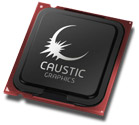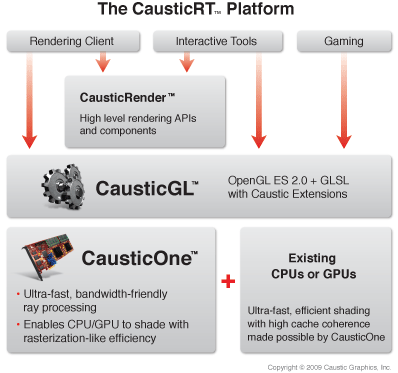RTPU: The Next Step in Graphics Rendering
Move over GPU... literally, move over, as the RTPU is the next step up on the technology ladder, bringing added photo-realism to gaming and other graphics-intensive applications without the huge processing load.
It feels like centuries since id Software's first-person shooter Quake required a math co-processor. Soon after the game's release, 3DFX launched the first-ever dedicated GPU, revolutionizing gaming visuals by turning pixelated polygons into smooth, three-dimensional shapes that appeared more realistic than ever. When Agia introduced the PhysX processor after the turn of the century, the visuals took on more of a realistic appearance by introducing physics, depicting the natural movements of objects, and how they interact with the environment. Now Caustic Graphics wants to take the next step into providing the ultimate experience with its dedicated ray-tracing processing system, the CausticRT.
The new system's CausticOne ray-tracing processing unit(RTPU) isn't meant to replace the GPU. In fact, it's job is to enhance the graphics much like Agia's PhysX, however the CausticOne doesn't deal with physics in terms of movement, but rather where the incoherent light rays scatter in a particular scene. Typically, ray-tracing requires that the PC or Mac process the entire scene, not just the visible areas, eating up valuable memory and CPU processing. This usually takes a large chunk of time on a single machine, especially when rendering high-resolution scenes in programs like 3DS Max and Maya. In fact, Pixar and other CGI companies have dedicated "farms" in order to render those realistic movies in an acceptable timeframe. According to the company, the average render time today for a single ray-traced image at film resolution is over three hours.
However, the CausticRT system supposedly removes the immediate bulk of the ray-tracing calculations off the GPU and CPU, using what the company calls a "breakthrough algorithm" that addresses the rendering issue and organizes the incoherent rays into a data flow. Thus, the processor sends the ordered data to the GPU and CPU. Ultimately, the CausticRT system will render ray-traced scenery with rasterization-like efficiency, producing photo-realistic graphics 20 times faster than anything on the market today.
"CausticRT does not displace a GPU or CPU in a graphics system, rather it acts as a co-processor that traces rays and schedules the results in a manner that allows GPUs or CPUs to shade them as efficiently as they do with rasterization," said James McCombe, co-founder and CTO of Caustic Graphics. "We are working with an emerging developer community to create new or port their existing renderers and applications to Caustic so artists and designers can take advantage of the photorealism and visual effects that make ray-tracing so compelling over rasterization."
Unfortunately, the CausticRT platform isn't ready for the general public, costing around $4,000 for the CausticGL driver, the CausticOne processor and accelerator card, and one year of firmware and software updates. The company also said that developers may also purchase a one-year subscription for US $2,500 that includes support for up to 10 incidents. However, it may be possible that the general public will see the CausticRT platform in the not-too-distant-future, as the company suggested that game consoles could achieve film-quality run-time visuals using the system. Could this processor be included in the next generation of Xbox and PlayStation consoles? Perhaps so. And like Agia, it may be possible that the CausticRT system will become a part of the Nvidia--or AMD for that matter--collective.
Stay tuned for the official announcement of the CausticOne accelerator card this Wednesday.
Get Tom's Hardware's best news and in-depth reviews, straight to your inbox.

Kevin Parrish has over a decade of experience as a writer, editor, and product tester. His work focused on computer hardware, networking equipment, smartphones, tablets, gaming consoles, and other internet-connected devices. His work has appeared in Tom's Hardware, Tom's Guide, Maximum PC, Digital Trends, Android Authority, How-To Geek, Lifewire, and others.
-
manjyomethunder "Typically, ray-tracing requires that the PC or Mac process the entire scene, not just the visible areas"Reply
I got lost when you said "PC or Mac", which made about as much sense to me as drinking "Soda or Pepsi". -
it won't do anything if the games aren't programmed for it...Reply
so its just a giant money sucker paperweight until the game devs stop sitting on their asses making the same game with a new game...
the software is well behind the hardware in the present -
deltatux Yes and in 5 years we will have a CPU with RT, and GPU in its die?Reply
How many cores can we shove? lol. -
meant to be "same game with a new name..."Reply
sorry toms doesn't have a edit feature... not much i can do about that feature though -
theuerkorn ReplyUnfortunately, the CausticRT platform isn't ready for the general public, costing around $4,000 for the CausticGL driver, the CausticOne processor and accelerator card, and one year of firmware and software updates. The company also said that developers may also purchase a one-year subscription for US $2,500 that includes support for up to 10 incidents. However, it may be possible that the general public will see the CausticRT platform in the not-too-distant-future, as the company suggested that game consoles could achieve film-quality run-time visuals using the system. Could this processor be included in the next generation of Xbox and PlayStation consoles? Perhaps so. And like Agia, it may be possible that the CausticRT system will become a part of the Nvidia--or AMD for that matter--collective.
Well, let's hope it will be affordable sometime soon. Of course they will need some support from a company with deep pockets and a product line it possibly supports (all the usual suspects ... AMD, nVidia, even intel though the latter may try to compete with Larrabee). On the other hand, the majority of PC gamers is frugal and high-tech extensions for several hundred bucks are strictly for enthusiasts (or a small percentage and market). -
buzznut Yeah, I thought the "future" was moving the gpu onto the cpu core and eliminating the graphics card, not creating new cards.Reply
This seems a little out of sync with where the industry is going.
I like the idea of having say a 16 core processor, and four cores are running graphics, 8 running 16 threads, and the other four cores are dedicated to sound, physics, raid, and networking. Or something like that.. -
A Stoner I read about these guys here about a month ago? It seems they have lost some venture capital or something to have such steep pricing for what really amounts to a research and developement franchise. It will be welcome to have these guys absorbed into the Intel/nVidia/AMD embrella, because I seriously doubt they have the ability to take this venture out to the full spectrum of the public. Maybe Microsoft will be in line to buy them as well, as I think they are invested into ray-tracing.Reply -
curnel_D I just typed out a huge explanation and a bit of insight for this tech, but the useless toms site and it's terrible support for anything internet explorer just erased the whole thing. So screw it. Meh.Reply -
FlayerSlayer thogromit won't do anything if the games aren't programmed for it...so its just a giant money sucker paperweight until the game devs stop sitting on their asses making the same game with a new game...the software is well behind the hardware in the presentIsn't that the same argument as PhysX? But if this goes the way that did, it could become ubiquitous on video cards in the future, making it worthwhile to program for, making it worth having on the cards.Reply


